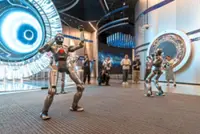Loona looks like a tiny dog on wheels, and may be described as a cross between a social robot and a security robot. — KEYi Technology
While the first thing that most people think of when it comes to having a robot at home is usually some sort of robovacuum that skitters around on its own, there’s a lot more to the world of home robotics.
Take Jibo, a social robot designed by Massachusetts Institute of Technology robotics professor Cynthia Breazeal, which could recognise faces, understand and respond to things people say, do home assistant tasks, and even dance.





